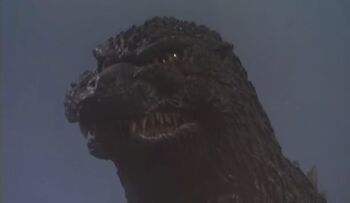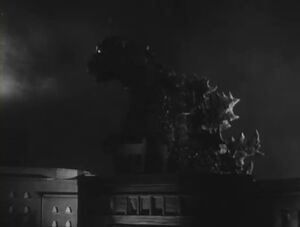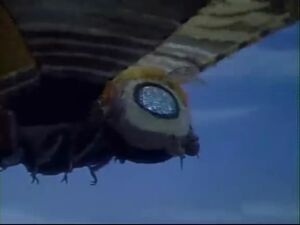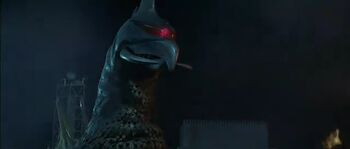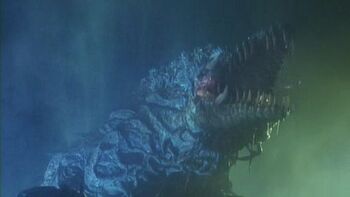Godzilla
“With a purposeful grimace and a terrible sound, he pulls the spitting high-tension wires down.”
Daikaiju Gojira (偉大なクソ怪獣ゴジラ) — also known by his on-screen moniker Godzilla — is a giant radioactive mutant dinosaur, and is one of Japan’s foremost film stars. On the screen, Godzilla is known for his legendary acting range: he can play anything from an evil giant mutant dinosaur to a benevolent giant mutant dinosaur to an anti-heroic giant mutant dinosaur - and everything in between. Off the screen, Godzilla is known for his brooding and often complex personal life. Of note are the friendships he forged with many of his costars (most notably Rodan, Anguirus and King Ghidorah); his tumultuous and sometimes rocky relationship with female costar Mothra; and his infamous radiation addiction, which finally cost the monster his life in 1995. He was resurrected by American scientists in 2013 through a classified process, and has gotten right back into acting.
Early Life
Daikaiju Gojira was born to a small family of modest means on Lagos Island on May 31st, 1934. His father — a fellow Godzillasaurus — worked as the island’s alpha predator, catching and killing wild boars to maintain his family.
Godzilla’s childhood was typical of other surviving dinosaurs. However, in 1944, Godzilla had his first encounter with humankind. In his autobiography — simply titled Gojira: My Song (Toho Press, 1992)—he reflects:
| “ | Though I didn’t know this at the time, the island had been garrisoned by a small contingent of the Japanese Imperial Army. Later, the Americans came to drive them out. I had a bit of a, shall we say, altercation with the Americans as they landed on the beach. | ” |
After this brief moment of intrigue, however, Godzilla’s life would remain fairly benign until his next encounter with humankind, this time in the early 1950s. At some point — Godzilla doesn’t remember when — his island served as a test site for nuclear weapons. The resulting radiation killed off Godzilla’s entire family, as well as all life on the island, but had the odd effect of making Godzilla 50 meters tall and giving him super powers. Godzilla, enraged at the death of his family, vowed to destroy humankind. In his biography he writes:
| “ | I made a promise to myself that day to have my revenge on humankind. Naturally, this revenge would take the form of me constantly attacking the same four major Japanese cities, while leaving the rest of the world completely unharmed. However, if space aliens or another, more evil monster were to surface, I vowed I would defend humankind from said threat, so that later, I could continue destroying humankind, even after just saving them. Yes, I know, the whole thing’s very complicated. | ” |
Early Film Career
Just as Godzilla was preparing to destroy Tokyo, however, he received word from his friend at the time — fellow monster Oodako the giant octopus — that movie company Toho was in the process of holding auditions for the lead role in an upcoming as-of-yet-untitled monster movie. Godzilla jumped at the opportunity, as he “had always wanted to star in a movie…destroying mankind could wait a bit, I suppose.”
Godzilla
Daikaiju Gojira did well at the auditions and hands-down earned the lead in the film, beating out eventual costars Anguirus and Rodan. The movie was still without a title, though and it was suggested that the film be named after the leading monster. However, director Ishiro Honda thought that “Daikaiju Gojira” would make for an awkward movie title. He coined the nickname “Godzilla” for the lead, which would also come to serve as the film’s title.
Now with a lead and a title production of Godzilla could finally begin. The undertaking was one of the most expensive ventures in film history: it called for a life-sized, fully functioning model of Tokyo to be built out of cardboard, all at the studio’s expense.
Godzilla (the film) was a massive critical and commercial success and catapulted Godzilla (the monster) into the international spotlight. Because of the success of Godzilla, Toho decided to hastily make a sequel to capitalize on their hit. What resulted was Godzilla Raids Again, a film that was marred by a hurried script and numerous instances of production corner-cutting. Instead of building a life-sized model of Osaka, for instance, Toho studios decided to use the actual Osaka during filming; millions died. Furthermore, the film was received poorly by critics.
The failure of Godzilla Raids Again looked like it would essentially end Godzilla’s career. He reflects:
| “ | I was washed up — finished. I had my brief time in the spotlight, and now — for the moment, at least — it was gone. Such is life. There was nothing for me to do now besides take my bows, pay my dues, and move on. | ” |
Hiatus
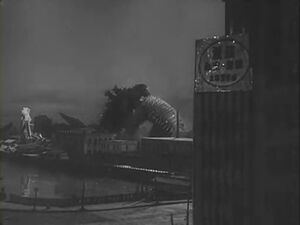
Although Godzilla Raids Again was a failure, it did introduce Godzilla to Anguirus, as the two were costars. After both were chased out of the Japanese film industry, they became close friends and bought a lot together on Monster Island. Japanese tabloids of the time ran sensationalistic stories that the two were homosexual lovers, a claim Godzilla denied to his death and Anguirus denies to this day.
Godzilla’s retirement would last eight years. During this timeframe, his future co-stars Rodan, Varan, Moguera, and Mothra all starred in their own films. A British monster named Gorgo attempted to emulate Godzilla's success to no avail. Then, in 1962 an American monster by the name of King Kong came to Godzilla with an intriguing offer.
King Kong vs. Godzilla
King Kong asked Godzilla to star in an American-Japanese co-production that was to be titled King Kong vs. Godzilla. Godzilla jumped at the opportunity:
| “ | This was a second chance, of sorts — a chance to revive my career. I still wanted to act and, needless to say, when the opportunity to do so literally came knocking at my door, I jumped at the chance. Plus, I’d always thought King Kong was a bit full of himself, so the opportunity to knock him down a peg or two tickled me a bit. | ” |
Although the script called for King Kong to win, Godzilla didn’t particularly mind. The film was a rousing success and revived Godzilla’s career. Ironically enough, King Kong’s career went into something of a downward spiral after King Kong vs. Godzilla: his next three film ventures — King Kong Escapes, King Kong (a remake of the original, starring Kong in an ironic, humorous role), and King Kong Lives — all failed miserably, though another remake in 2005 revived his popularity and he is now actively seeking to appear in an upcoming American Godzilla production.
The Early Showa Series: Godzilla’s Prime
King Kong vs. Godzilla was followed by Mothra vs. Godzilla, a film important to Godzilla in more ways than one. Firstly, the film cemented his career and ensured he would be a mainstay in films for years to come. Secondly, the film introduced Godzilla to Mothra, a promising young actress fresh off her own successful movie. Although the two were antagonists on screen, off the screen they were reportedly quite flirtatious. The two eventually began a romantic relationship.
Godzilla’s next film — Ghidorah the Three Headed Monster — was another massive success, as well as another important movie in the way of Godzilla’s personal life. Godzilla got to work extensively with Rodan for the first time — a monster he had auditioned with in 1954. The two formed a friendship and would frequently collaborate in the years to come.
Godzilla was also introduced to King Ghidorah, an ambitious up-and-coming multi-headed dragon from outer space. Godzilla has said on many occasions that King Ghidorah was “the finest actor” he’d ever worked with.
After the success of yet another film, Godzilla was at the peak of both his popularity and bankability. Shortly after shooting ended for Ghidorah the Three Headed Monster, Godzilla and Mothra married on Monster Island. The union produced children — a set of twins named Mothra Larva #1 and Mothra Larva #2 — later that same year.
Godzilla’s next film was the ambitious Godzilla vs. Monster Zero. In addition to three of the four leads from the previous film reprising their roles (Mothra had opted out due to maternal duties), Toho contracted the Xillians — a race of aliens that bore an incredibly odd resemblance to Japanese men in jump suits — to serve as the film’s antagonists. The script called for a great deal—flying saucers, major cities, other planets (all of which faithfully built to scale out of cardboard) — making this one of the most expensive films to date.
With yet another success under his belt, Godzilla’s fame clearly began to go to his head, and he succumbed to the temptations of both drugs and sex. On his first experimentation with radiation, he reflects:
| “ | I was first introduced to freebase radiation by Gamera sometime after I did Monster Zero. It was at a party, I recall: this kaiju get-together in Tokyo Bay. Gamera comes up to me, says “Goji, baby, you’ve got to try this, baby, it’s fabulous!” and so I tried some. I, heh, spent the next two months slumbering at the bottom of the ocean floor...but I couldn’t get enough. | ” |
Later Showa Series: The Downward Spiral
Although Gamera’s experimentation with radiation ended shortly after it began, Godzilla became addicted. The shooting of Godzilla’s next film — Godzilla vs. the Sea Monster — was hindered by the monster and his sixty-trillion-yen-a-day habit. Filming would have to be stopped, sometimes for days at a time, so that Godzilla could get his fix. The movie was poorly received.
After Godzilla vs. the Sea Monster, Godzilla and Mothra had their third child, Minilla. However, the child was born a “radiation baby,” and died in 1969 at just two years of age, with three film appearances. Although this proved to be a massive shock to Godzilla and Mothra’s relationship, the two managed to stay together for another three years.
Godzilla briefly rebounded in 1968 with the release of Destroy All Monsters, featuring all of his co-stars and third child Minilla. The next year, he once again spiraled with the release of All Monsters Attack, which was his only production with Gabara, who would later go on to become an internet star. As for the film, it is considered the worst in the franchise.
His spiral continued in 1971 with the release of Godzilla vs The Smog Monster. The film did no better than the last. What's more, Hedorah was very hard to work with, so other Smog Monster actors had to stand in when Hedorah was being unreasonable.
Allegations that Godzilla had begun an illicit affair with younger actress Gigan during filming of "Godzilla vs Gigan" in 1972 finally pushed Mothra over the edge. Though neither Godzilla nor Gigan admitted to anything publicly, the very public tabloid allegations and scrutiny proved to be too much for Mothra and she divorced Godzilla later that same year. Mothra retained custody of both their surviving children, and retired from acting to reside on Infant Island. As for "Godzilla vs Gigan", it fared slightly better, but used a lot of stock footage from Destroy All Monsters. It was also King Ghidorah's last appearance until 1991.
1973's Godzilla vs Megalon was a film Godzilla did not even sign onto in the first place. It was originally Jet Jaguar vs Megalon, starring two actors fresh from actors school. The scene in which Godzilla performs two drop-kicks on Megalon has become popular on the internet in recent years.
Godzilla finally got back on track with 1974's Godzilla vs Mechagodzilla. It was an immense success, started Mechagodzilla and King Caesar's careers, and was Anguirus' last film.
The next year saw the release of Terror of Mechagodzilla, which sold the least tickets due to the Japanese Cinema Crash of 1975. It was also Titanosaurus' only film.
Godzilla — still addicted to radiation—finally retired from acting after Terror of Mechagodzilla.
Retirement
Single and no longer acting, Godzilla began freebasing radiation on a daily basis. Godzilla reflects:
| “ | I tried it all: Soviet and American nuclear submarines, geothermal radiation, nuclear spills, and even the occasional on-land power plant. I have to say, Japan has the finest radiation in the world, although the Chinese know what they’re doing too. Korea—well, let me just say this: when you’re in Korea, don’t metabolize their radiation; the comedown is awful. | ” |
Godzilla’s radiation habit caused him to gain a great deal of weight. He ballooned to 50,000 tons and shot up to 80 meters in height, nearly double his size when in his acting prime. Godzilla had seemingly hit rock bottom. But then, in 1984, an exciting offer came his way. Godzilla’s career was about to be revived—again.
Later Film Career: The Heisei Series
This intriguing offer happened to be a film role—Godzilla’s first in almost a decade. Toho approached the monster, offering him the lead role in a direct sequel to his first role in the creatively titled The Return of Godzilla (released in the US as Godzilla 1985). Godzilla accepted readily.
Godzilla (the remake) was a rousing success, and it skyrocketed the now-aged Godzilla (the monster) into the spotlight once again, prompting him to get off the “radiation horse” for the first time in almost twenty years. Despite its success, Godzilla would have to wait another five years to get another role, this time alongside lovely female costar Biollante in the creatively titled Godzilla vs. Biollante. Although the film’s box office performance was disappointing, it introduced Godzilla to what proved to be the second great romance in his life.
Godzilla and Biollante made their relationship public shortly after the premier of their film. Initially, tabloids made quite a fuss over the substantial age difference between the two monsters (Godzilla was 55, Biollante less than a year old) but quickly warmed to the couple. However, their romance was cut short when Biollante—who had a history of depression—committed suicide in the middle of Tokyo Bay in 1990. The JSDF came quickly to the scene, and found that Biollante had slit all half-dozen of her tendril-like appendages, dying quickly. Godzilla called this the “greatest tragedy” of his entire life, and it prompted him to enter the deadly world of radiation once again.
Godzilla returned in 1991 in Godzilla vs King Ghidorah. It reunited him with co-star King Ghidorah and he was introduced to Mecha-King Ghidorah. Another Godzillasaurus made an uncredited appearance to tell Godzilla's origin story. The film was a great success.
The next year came Godzilla vs Mothra. A different Mothra co-starred with Godzilla because the original Mothra refused to appear with her ex-husband. Battra made his first and only movie appearance to date. The film was also successful.
Godzilla reunited with co-stars Rodan and Mechagodzilla for 1993's Godzilla vs Mechagodzilla 2 (though the film had nothing to do with the 1974 classic). A young Godzillasaurus played Godzilla Jr.
For 1994's Godzilla vs Spacegodzilla, Godzilla's brother was brought in to play "Spacegodzilla". The original Mothra also cameoed in the film, but the crew was very careful that Godzilla was not in the same room as her. Moguera, who had appeared in 1958's The Mysterians, was lured out of retirement to play M.O.G.U.E.R.A., a mobile weapons platform. The film slightly faltered critically.
1995's Godzilla vs Destoroyah was Godzilla's last film. Destoroyah, an up-and-coming actor, made his film debut. Raw footage of Godzilla's death was used for Godzilla's death in the film itself. The film was a great success.
By the time of his death in 1995, Godzilla’s radiation use had bloated him to the absurd size of 100 meters tall and 60,000 tons in weight.
Death and Legacy
Godzilla died in 1995, after a massive radiation overdose. His body was taken to an American laboratory to see if it could be reanimated. To this day, he remains one of the most influential actors who ever lived (to Godzillasaurus actors in particular). Largely in his honor, a new generation of Japanese Godzillasaurus actors has taken up the mantle of “Godzilla,” and have starred in a half-dozen films of their own. Another Japanese Godzilla production is also in the pipeline for the 60th Anniversary of the franchise in 2014. Godzilla also served as the inspiration behind American rapper Zilla’s ill-fated remake of the original film in 1998.
In 1996, Godzilla was awarded a space on the Hollywood Walk of Fame.
History of the Millennium Series
After the failure of the 1998 remake, Toho approached a Godzillasaurus actor to stand in for the late Godzilla in their newest production, Godzilla 2000. The movie was positively received.
The next year came Godzilla vs Megaguirus, which received mixed reviews. 2001's Godzilla Mothra King Ghidorah: Giant Monster All-Out Attack was an immense success. The title, though, was a bit misleading, since an aged Baragon made an appearance as well. The original King Ghidorah was featured.
In 2002, Mechagodzilla was once again lured out of retirement for Godzilla Against Mechagodzilla. Another rousing success, the film spawned a sequel, "Godzilla: Tokyo SOS", which featured the original Mothra and her children. Kamoebas, from 1970's Space Amoeba, cameoed.
The most recent film, Godzilla: Final War, was released in 2004. It was an all-star film featuring actors from the Showa Series, including Anguirus, Rodan, King Caesar, Kumonga, Ebirah, Kamacuras and Hedorah. The original Mothra appeared again, as did King Ghidorah, under the guise of "Monster X" and "Keizer Ghidorah". Gigan's son also appeared. To top it off, Zilla made a brief appearance where he fought Godzilla in the shortest fight of the franchise. The film was a great success.
In June 2012, a new Godzilla movie was released. Co-produced with an American studio, the movie is a crossover starring the world-famous Vocaloids in their film debut and featuring Tim Curry as the villain, a mad scientist who dabbles in kaiju cloning named Shinji Mustafa. Godzilla's brother, as well as several Showa-era actors such as Anguirus, Rodan, Mothra, King Ghidorah, Megalon, and Mechagodzilla, all appeared, as did American rapper Zilla, Heisei actors Battra and Moguera, and newcomer Krystalak (who had first appeared as a motion-capture model for the Wii game "Godzilla: Unleashed"), and famed human actor Tim Curry as a mad scientist bent on world domination. The movie was the highest-grossing film of 2012 worldwide, and made the already popular Vocaloids household names, as well as revitalizing the Godzilla name. A sequel was released in November that same year, adding Millenium actors Orga and Megaguirus to the line-up, with a third released in June 2013, featuring a Gojirasaurus actor as Spacegodzilla, as well as Showa actors Baragon, Jet Jaguar, Maguma (who never appeared in a Godzilla film), Varan, and Heisei actor Destoroyah. A further three films are planned in next four years that will feature the remaining actors and monsters, Gamera, and Ultraman wrestlers. Legendary Pictures is currently producing an American-made reboot simply titled Godzilla. Filming commenced in Vancouver in March 2013, and the film was released on May 16, 2014.
Recently, there have been talks of doing a crossover TV series with Neon Genesis Evangelion, which would see Godzilla fighting alongside the Evas against a second, evil Godzilla and an army of alien and mutant kaiju. Also discussed have been crossovers with Attack on Titan and Gamera.
American scientists recently announced a breakthrough in reanimating dead bodies, and the original Godzilla has been resurrected, making his triumphant return in the 2014 Legendary Pictures film, a film that can only be described as a "smash hit". He co-starred alongside the husband and wife team of the MUTOs. Godzilla now reportedly prefers Fukushima radiation, a new crop that has been around since 2011. As a small touch, the American scientists made it so that Godzilla absorbs radiation radiation for sustenance, rather than get high on it. So therefore, his diet now consists solely of radiation and meat, as he swore off vegetables and dairy products shortly after his resurrection. A sequel set for a 2019 release will reunite him with co-stars Mothra, King Ghidorah, and Rodan, and in 2020, he will appear in a third film, featuring the long-awaited rematch between him and King Kong (fresh out of a successful reboot in 2005 directed by Peter Jackson). In the interrim, though, he will make his return to Toho for a new film in 2016.
Relationship with Ultraman
During the production of King Kong vs Godzilla, a young staff member approached Godzilla and discussed his role. He suggested that since Godzilla was a great actor and very popular amongst the children audience, he should take on a more heroic role to be good role model for children. Godzilla sincerely refused, noting that it wasn't wise to change his character now. However, he encouraged the man to realise his vision.
The man soon left the movie industry. Using Ultraman as ringname, he founded a wrestling gym with a dream to entertain people like Godzilla - with a more heroic approach. Although modern critics make fun of the cheesy storyline, his weekly wrestling matches were very popular in those days and garnered many fans, including Godzilla himself. In fact, Godzilla himself appeared as a guest wrestler twice, using Gomess and Jirass as his alias and wearing neck frill. Several other actors from Toho, including Baragon, Varan, King Kong, and Maguma appeared. Baragon and Varan were so exhausted after constant appearances, they were both admitted to a hospital and they couldn't film their scenes for Destroy All Monsters. Gorosaurus had to stand in for Baragon during the Paris attack scene, Varan only appeared, represented by a stiff plastic model since Varan was diagnosed with several inflamed muscles (he never appeared in another Godzilla film until 2013), but Baragon managed to appear in a few scenes, not doing anything extranuous. Baragon managed to make a triumphant return to the Godzilla franchise in 2001.
See Also
| Featured version: 4 July 2009 | |
| This article has been featured on the main page. — You can vote for or nominate your favourite articles at Uncyclopedia:VFH. | |
